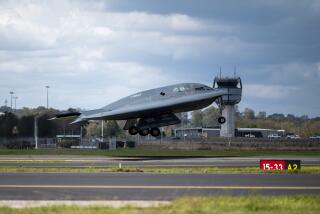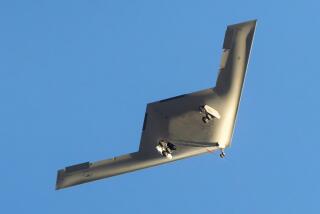Cheney Seeks Full Production of B-2 : Military: The secretary rejects a plan to stretch out the Stealth schedule. The decision could be a boon to the Southern California defense industry.
- Share via
WASHINGTON — Defense Secretary Dick Cheney has decided to push for full-paced production of the B-2 Stealth bomber next year, giving a boost to the embattled plane at a time when many programs face dramatic cutbacks, Defense Department sources said Wednesday.
Cheney’s decision, one of his first affecting a major program in the next fiscal year, overrules a recommendation made by the Air Force to “stretch out” the B-2’s production schedule to save money and avoid painful reductions in other areas. Although the decision faces White House review and a tough test in Congress, its success would be a boon to the defense industry in Southern California, where the Northrop Corp. employs 12,000 workers on the project at its Palmdale and Pico Rivera facilities.
“This secretary has made clear that we are going to make cuts the old-fashioned way: We’re going to terminate programs and we’re going to (close production lines early) and we’re going to close bases,” said one senior defense official. “We are not going to just stretch programs out.”
Less than a week ago, Air Force Secretary Donald B. Rice said that the production of 132 B-2s should be stretched out to meet budgetary constraints. But in overruling the recommendation, Cheney decided to stick with the production schedule drawn up before President Bush ordered the Pentagon to scale back its 1991 budget request by $18 billion.
The current plan advocated by Cheney calls for building five of the $500-million bombers in 1991, 10 in 1992, 21 in 1993, and 24 in 1994. The remainder are scheduled to be completed by fiscal year 1996.
Cheney’s decision is one of the first specific program decisions to emerge from the Pentagon as senior defense officials sift through programs for the last time before forwarding a draft defense budget to the White House. Officials said that Cheney has rejected many other service recommendations to stretch out programs, insisting on sacrificing lesser priorities once and for all.
“A bunch of terminations are coming,” said one defense official who spoke on condition he not be named.
Sources said that Cheney rejected the Air Force “stretch-out” initiative when aides argued that it would likely raise the already-formidable price tag of the futuristic bomber. By flattening yearly production, the service would have to keep the production facilities of Northrop and its more than 4,000 subcontractors running for at least a year beyond 1996.
While Cheney’s decision is expected to squeeze other Air Force priorities vying for funds, service officials hope that the program will win congressional support if its cost does not grow further.
Cheney’s decision, if accepted by the President, is likely to draw some criticism on Capitol Hill. Commenting on the Air Force’s proposed funding projections for the B-2, which would peak at $8 billion in 1994, Rep. Les Aspin (D-Wis.) told senior Air Force officials in July there is “no chance, no chance” that Congress would appropriate so much in a single year on one program.
According to one former defense official active in shaping the B-2 program, the Air Force has long advocated that production of the 132 bombers start slowly and last longer, since the service believes that the B-2 is one of its last “deep pockets” programs.
Bowing to a congressional directive, the Air Force is studying how much could be saved by cutting production of the proposed 132-bomber force to a total of 66 or 99 aircraft, according to Air Force officials. They have argued vehemently against cutting the overall number of B-2 bombers.
The congressionally directed study has caused the Air Force to lay new emphasis on the bomber’s potential uses in Third World conflicts.
The Air Force is reviewing the role and composition of its entire bomber fleet, from the aging B-52 to the new B-2, with an eye toward using the planes for conventional attacks as well as delivering nuclear bombs. As the likelihood of all-out nuclear war with the Soviets recedes, the Air Force is trying to redefine itself as a service capable of operating in a wide range of contingencies.
Big bombers equipped with long-range cruise missiles with conventional warheads could be used for strikes against terrorist targets or in support of limited Navy operations, Air Force analysts now argue. They say that bombers can reach any target in 12 hours or less, much more quickly and cheaply than a Navy aircraft carrier task force.
The Stealth bomber’s unique batlike shape and the radar-absorbing materials that coat the craft’s surface are designed to allow the aircraft to penetrate Soviet air defenses and attack heavily defended targets inside the Soviet Union. In recent months, however, the Air Force has emphasized the plane’s range, which enables it to attack targets in distant places, such as Libya, from bases inside the United States.
Speaking to reporters last week, Rice called the B-2 program the Air Force’s “top priority in strategic modernization.”
The Air Force has insisted that the U.S. negotiating position in the Strategic Arms Reduction Talks assumes that the Air Force produces a 132-plane force of Stealth bombers. If Congress kills the bomber or scales it back, Air Force officials have said the United States would have to redraft its negotiating position.
But many lawmakers and even some proponents of the program say that the service will be forced by budget pressures to build fewer than 132 of the multimillion-dollar aircraft.
“There was really nothing absolutely precise about the 132 number,” said one former Pentagon official involved in the early planning of the program. “Did we and the military leadership really think the world was going to come to an end if we didn’t get all of those? No,” the former official added.
MILITARY CUTBACK--Defense officials have decided to cut 25,000 men and women from the military in 1990. A35
THE STEALTH BOMBER Number proposed to be built: 132 Projected cost of program: $68 billion Range: 6,000+ miles before refueling Dimensions: 17 feet high, 69 feet long, 172-foot wingspan Air crew: Two Mission: Penetrate Soviet air defenses undetected and attack mobile and heavily defended targetssuch as command posts and missiles based on rails and trucks.
More to Read
Sign up for Essential California
The most important California stories and recommendations in your inbox every morning.
You may occasionally receive promotional content from the Los Angeles Times.











